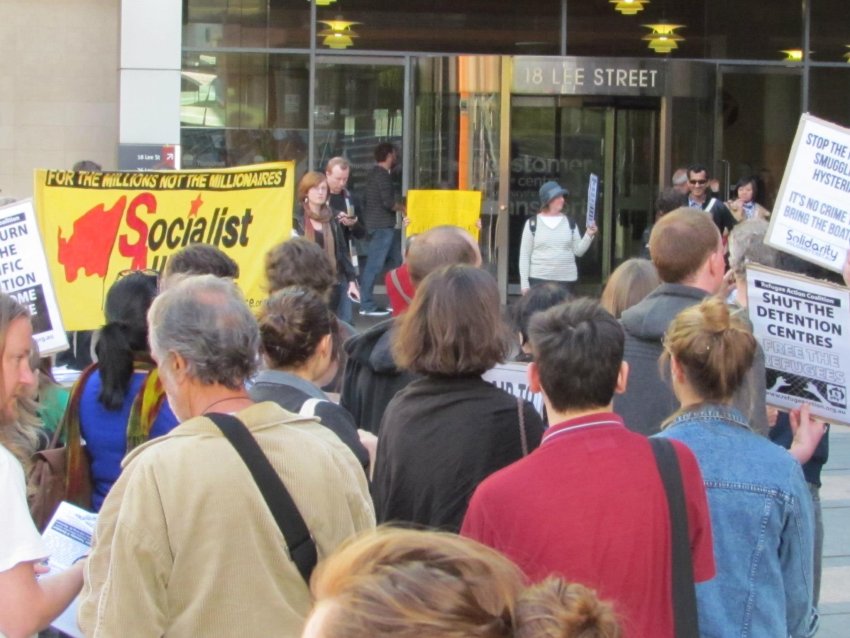
Forty Tamil asylum seekers were flown to Nauru overnight on September 13, marking the beginning of Labor’s “Pacific solution” and a return to offshore processing. The group on Christmas Island were reported to have been under guard of federal police and did not resist.
An earlier High Court decision on September 7 rejected the right of asylum seekers to appeal against pending deportations. The court ruling also makes possible further forced returns of refugees to danger.
These two events show the Labor government’s willingness to engage in the mass expulsion of people who need protection. Immigration minister Chris Bowen has even tried again to float Labor’s failed Malaysia-Australia “human swap” plan.
Labor’s refugee policy is all about trying to look “tough” on border control and stymie Coalition point scoring. Human rights, saving lives and “stopping the boats” have little to do with it.
The immigration department has produced YouTube videos (below) showing the dilapidated conditions on Nauru, and overgrown tropical jungle of Manus Island to show refugees what Australia will do to them if they take a boat.
But far from blunting the Coalition’s criticisms, Labor’s new refugee policy has encouraged stronger attacks on the rights of refugees. Coalition MPs have called for refugees to be placed on punitive temporary protection visas and for the navy to repel refugee boats at sea.
Labor and the Coalition’s race to the right on refugee rights will affect the lives and well-being of thousands of asylum seekers.
The group of 40 Tamil men were ushered onto a chartered plane from Christmas Island on the evening of September 13. The Australian reported the plane was scheduled to also stop over in Darwin, where refugee advocates said the Darwin Airport Lodge detention facility was in lockdown with buses waiting outside.
However, the whole event was “cloaked in secrecy”, the Sydney Morning Herald said, because the government was “fearing a last-minute injunction”.
The government intends to imprison 2100 people on Nauru and Manus Island. Neither site is prepared or adequate for so many, yet more than that number have already arrived by boat since August 13 when a government-appointed “expert” panel first recommended the island detention camps be reopened.
Conditions on Nauru are appalling. So far a “tent city” has been thrown up by soldiers, where male asylum seekers will live for up to six months.
ABC reporter Kirrin McKechnie said the shower and toilet block was still being built and kitchen facilities were not yet running by September 11. She posted photos on Twitter of rows of army tents, built atop muddy ground but with “wooden flooring, lighting and power points”, each of which will house five people.
Contracts have been handed out to private companies to run the camps. A $24.5 million contract for “catering, cleaning, security, transport and facilities” on Nauru and Manus Island was awarded to multinational corporation Transfield.
The same company that holds the contract for Australian detention centres, International Health and Medical Services, will run the Nauru camp’s health services. It will be paid $22 million. The Detention Health Advisory Group criticised the company in a parliamentary committee hearing earlier this year for its inadequate and often negligent treatment of asylum seekers.
The Salvation Army will run “social services” on Nauru and Manus Island.
The September 13 Australian said that the Australian government says it has “no legal responsibility whatsoever” for refugees processed under the “Pacific solution”. UN refugee agency spokesperson Richard Towle said the government told him “the Australian position is that all international legal responsibility passes to Nauru”.
What legal protections asylum seekers will have while they are in Australian-imposed limbo have not been defined. Further, Australia’s contracts with private companies managing refugee detention, such as Serco in Australia, contain “confidentiality” and “non-disclosure” clauses.
Already, a new crisis is brewing for the government’s offshore processing fiasco. More asylum seekers have arrived, as people desperately sought boats from Indonesia, aware that Australia was, in effect, closing its borders. More than 2300 people have been picked up and taken to Christmas Island since the new refugee policy was announced.
This ironic twist on the two big parties’ “stop the boats” mantra shows that even risk of drowning or offshore detention does not compare with the suffering and danger that refugees try to escape.
The illogical “no advantage” policy means that once these centres are filled, those held will remain, ostensibly part of an “orderly queue” with refugees in camps around South-East Asia, for at least five years and possibly much longer.
Asylum seekers that have been processed onshore are now also battling to stay safely in Australia. More refugees are having their protection needs rejected and are finding their legal avenues to resist deportation exhausted.
Forced deportations of asylum seekers take place at the discretion of the immigration minister. The recent High Court case sought to allow five rejected refugees the right to make an independent appeal against the minister’s decisions.
More than 200 refugees could be affected by the decision. This includes Hazara refugee Ismail Mirza Jan, who said last year that they should just “send my dead body” because he knew he would be killed if deported to Afghanistan.
The decision means the government can now legally deport Afghan refugees back to their home country, where many have fled violence from the Taliban, the warlord government and occupying forces.
Australia signed a deal with the corrupt Karzai government in 2010 to allow unwilling refugees to be returned, including children. Violence in Afghanistan has grown steadily worse and Australia’s own travel advice says those travelling in Afghanistan “should consider leaving”.
Most refugees facing deportations now are Tamils. In August, refugee advocates were shocked by the sudden forced deportation of Tamil man Dayan Anthony, who was immediately detained by Sri Lankan police and interrogated for 16 hours before publicly recanting his claims of torture, despite such claims being verified by Australian doctors.
Other refugees that have voluntarily returned have disappeared, been arrested and killed.